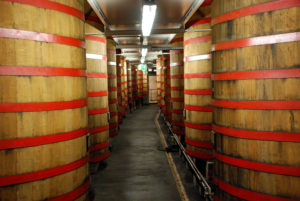 You might get the impression that we, the beer gurus of ACB, understand all there is to know about beer, yet we’re still learning, just like anybody else. And it’s this thirst for knowledge that drives us to dig deeper into the stories behind the beers we drink, thus protecting you from the embarrassment of not knowing what exactly it is you’ve decided to pour in your mouth.
You might get the impression that we, the beer gurus of ACB, understand all there is to know about beer, yet we’re still learning, just like anybody else. And it’s this thirst for knowledge that drives us to dig deeper into the stories behind the beers we drink, thus protecting you from the embarrassment of not knowing what exactly it is you’ve decided to pour in your mouth.
So welcome to the latest in our ongoing series (drum roll please…) “What the Hell Is a Flanders Red?”
The Basics:
If you’re familiar with the various sour ales of Belgium, you might already be rolling your eyes and thinking, “Aren’t Flanders Red and Browns and Oud Bruins all the same?” Yes and No is about as exact as we’ll get on that classification, suffice it to say that it’s complicated. So here’s a bit of what each are, what they’re not and we’ll let you decide.
 A little over a year ago, we took on the Oud Bruin or East Flanders style, which in our humble estimation, can in many ways be different from the traditional West Flanders, Flemish Red or Flanders Red ale. What they share in common is that they are distinctly unlike the Lambic style which comes from the wheat tradition (instead of barley) and is completely fermented spontaneously.
A little over a year ago, we took on the Oud Bruin or East Flanders style, which in our humble estimation, can in many ways be different from the traditional West Flanders, Flemish Red or Flanders Red ale. What they share in common is that they are distinctly unlike the Lambic style which comes from the wheat tradition (instead of barley) and is completely fermented spontaneously.
Conversely, these brown and red sours are of a more learned era when brewers could control which bacteria they were adding – in this case Saccharomyces , Lactobacillus, Pediococcus and a secondary dose of Brettanomyces, a mixed culture recipe that is said to have originated at Rodenbach.
Now here’s where the details get sketchy. We’ve read that the term “Flanders Red” was coined by Rodenbach as a marketing tool, setting it apart on shelves from the Oud Bruin style. While we don’t make it a habit of relying on home brewer forums for facts, when those references are first-hand accounts from Belgium and possibly the renowned critic Michael Jackson, it can give one pause.
The main difference, based on the Rodenbach method, is that Flanders Reds are aged in barrels or foeders for 8 to 18 months (depending on the brand), that cocktail of bacteria added in secondary fermentation, then a blending of older foeders with newer ones. Oud Bruin, in the Liefmans Goudenband tradition, is brewed with the three bacterial strains added to the mash, open fermented like a lambic, then added to stainless steel tanks – aged without Brett or a barrel. But again, many brewers will age Oud Bruins in foeders or barrels too, so… go figure.
As far as the BJCP is concerned, the Flanders Red is more “red wine-like” due to the generally fruity flavor (black cherry, plum, orange, red currants, etc.), featuring a “balanced to intense sour aroma,” with barrel-aging providing a more tannic and generally drier finish. The Oud Bruin, on the other hand, is described as a “malty, fruity, aged, somewhat sour, Belgian-style Brown Ale.”
From our experience, you can definitely taste the difference in a side-by-side tasting, though again, these styles vary depending on the brewery, barrel-aging and blending, where they’re brewed, and while the Reds may look Brown and vice-versa, don’t get hung up on the color. You really can’t go wrong with either option.
Flanders Reds We Like and You Should Try:
Duchesse de Bourgogne – Brouwerij Verhaeghe (Victhe, BE) – If you’ve never had a s our beer, much less a Flanders Red, this is a great place to start. It’s not too sour, certainly sweet and has a vinegary acidity that’s distinctly all its own. This one’s definitely a mellower offering and an easier quaff. 6%
our beer, much less a Flanders Red, this is a great place to start. It’s not too sour, certainly sweet and has a vinegary acidity that’s distinctly all its own. This one’s definitely a mellower offering and an easier quaff. 6%
Alexander – Brouwerij Rodenbach (Roeselare, BE) – We used to think that Rodenbach’s Grand Cru, one of the finest Flanders Reds, was indeed the best. Now that Alexander was been released here for the first time in 16 years last summer, it’s clear we were wrong. The blend is two-thirds 2 year old foederbeer and one-third young ale “macerated with cherries.” Definitely seek this one out ASAP. 5.6%
Oude Tart – Bruery Terreux (Placentia, CA) – While it’s difficult to say exactly which brewers in the United States have truly nailed this style, it’s safe to say that The Bruery creates one of the best. Aged in red wine barrels for up to 18 months, this “Flemish-Style Red” is also available with fruit additions of Cherries, Boysenberries and Raspberries. 7.5%
Our Take:
Say what you will about the geography of where a beer is conceived or the varying hues defining its name, the Flanders Red style is a distinctly unique sour Belgian Ale that both newcomers to the style and seasoned palates will enjoy. And while the brewers here in America are turning out some phenomenal renditions of this classic sour ale, don’t forget to seek out the real thing, straight from the shores of Belgium.
Special thanks to All About Beer for historical guidance.
Header courtesy of kegerator.com
Flanders Red photo by Warren Wills
 American Craft Beer The Best Craft Beer, Breweries, Bars, Brewpubs, Beer Stores, And Restaurants Serving Serious Beer.
American Craft Beer The Best Craft Beer, Breweries, Bars, Brewpubs, Beer Stores, And Restaurants Serving Serious Beer.
